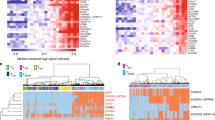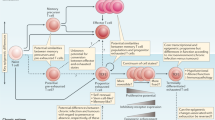Abstract
Maris et al. reply — Mantovani suggests that expression of human placental alkaline phosphatase in activated T cells might stimulate an immune response against PLAP and that the anti-PLAP antibodies generated could lead to the elimination of CD8+ T cells expressing large amounts of PLAP on their surface. We therefore tested whether doubly transgenic (GranzymeB–Cre × CD2–STOP–PLAP) mice could mount an antibody response against PLAP during the course of a response against LCMV, and whether the serum of these mice contained antibodies against human PLAP.
Similar content being viewed by others
Main
We infected doubly transgenic mice (n = 15) with 5 × 104 plaque-forming units of the Armstrong strain of LCMV and nine days later collected their serum to test for the presence of antibodies against human PLAP in an enzyme-linked immunosorbent assay (ELISA). None of the fifteen LCMV-infected doubly transgenic mice produced anti-PLAP antibodies, as shown by a representative ELISA from five LCMV-infected (day 9 post-infection) doubly transgenic mice (Fig. 1a).
a,b, Mice do not produce antibodies against placental alkaline phosphatase (PLAP) (a), but are able to mount a good antibody response against LCMV (b). For enzyme-linked immunosorbent assays, 96-well flat-bottom Immunoplates (Nunc) were coated with purified PLAP protein (Anawa Trading SA, Zurich; 80 ng per well) for 2 h at 37 °C (a) or with a lysate from LCMV-infected BHK-21 cells (b). Plates were blocked with 4% non-fat skimmed milk and 0.1% Tween 20, and duplicate dilutions of serum from GranzymeB– Cre × CD2–STOP–PLAP doubly transgenic mice (infected 9 d previously with LCMV Armstrong) were allowed to bind for 90 min. A monoclonal antibody against human PLAP (clone 8B6; Sigma) and LCMV immune serum were used as positive controls for detecting PLAP and LCMV, respectively. After extensive washing, plates were incubated with goat anti-mouse IgG conjugated to horseradish peroxidase (Sigma) for 90 min. After washing, the substrate o-phenylenediamine (Sigma) was added and the colour developed was quantified 30–40 min later on a Spectramax 340 plate reader (Molecular Devices) at 492 nm (ref. 3). Background absorbance from wells with no antigen was subtracted from antigen-containing wells at each dilution. The absorbance at 492 nm is plotted against the reciprocal of the serum dilution.
To find out whether these mice mount a strong antibody response against LCMV, we tested the serum from the same 15 mice for antibodies against LCMV and found that 14 of the 15 mice mounted strong antibody responses against this virus. Figure 1b shows the anti-LCMV antibody levels in the same five mice that were used to obtain the results shown in Fig. 1a — four out of five mice mounted strong anti-LCMV antibody responses.
These results indicate that the low frequency of PLAP-positive CD8+ T cells (10%)1 compared with the LCMV peptide/MHC tetramer-positive CD8+ T cells (70%)2 observed in the acute phase of the LCMV response is not due to an antibody response against the human PLAP reporter and antibody-mediated elimination of PLAP-expressing CD8+ T cells. But we still need to investigate why PLAP marks only a subset of the activated CD8+ T cells.
References
Jacob, J. & Baltimore, D. Nature 399 593–597 (1999).
Murali-Krishna, K. et al. Immunity 8 177–187 (1998).
Kuvstak, E. Enzyme Immunodiagnosis (Academic, San Diego, 1986).
Author information
Authors and Affiliations
Rights and permissions
About this article
Cite this article
Maris, C., Jacob, J. & Baltimore, D. reply: Investigating T-cell memory. Nature 407, 40 (2000). https://doi.org/10.1038/35024161
Issue Date:
DOI: https://doi.org/10.1038/35024161
Comments
By submitting a comment you agree to abide by our Terms and Community Guidelines. If you find something abusive or that does not comply with our terms or guidelines please flag it as inappropriate.




